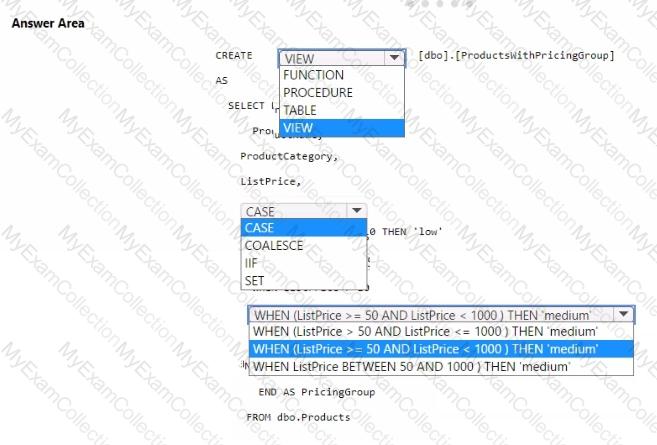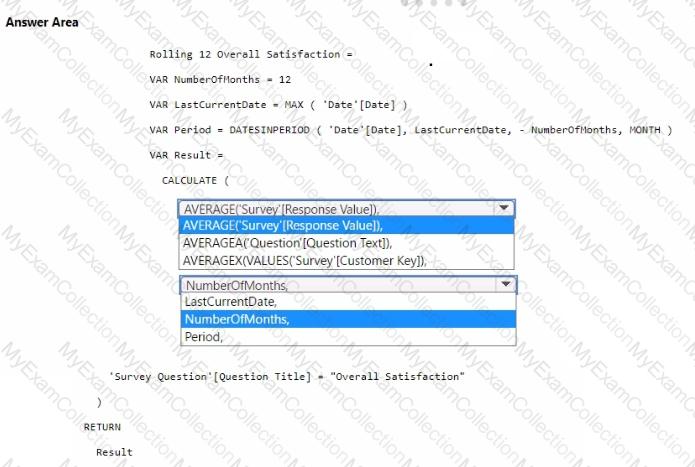You need to resolve the issue with the pricing group classification.
How should you complete the T-SQL statement? To answer, select the appropriate options in the answer area.
NOTE: Each correct selection is worth one point.
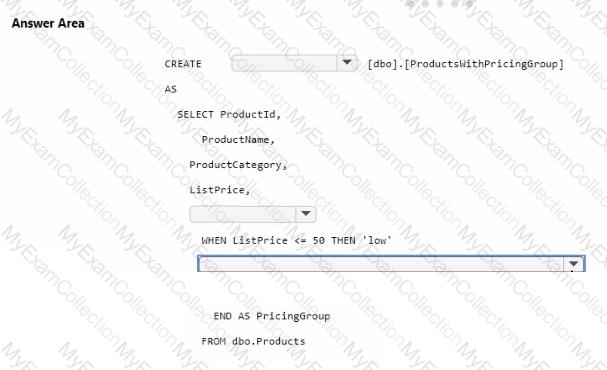
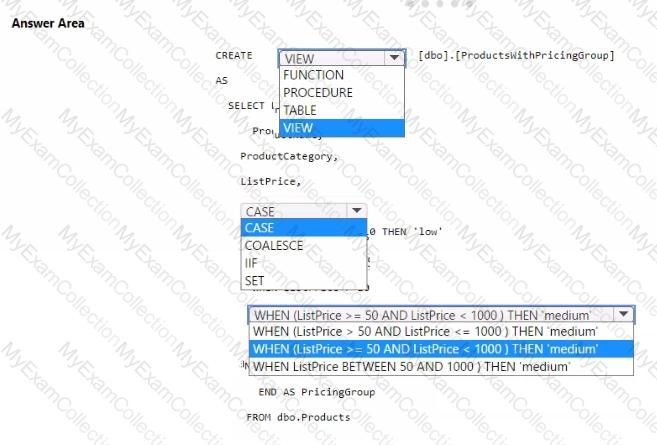
You have a Fabric tenant that contains a workspace named Workspace_DEV. Workspace_DEV contains the semantic models shown in the following table.

Workspace_DEV contains the dataflows shown in the following table.


You have a Fabric tenant that contains JSON files in OneLake. The files have one billion items.
You plan to perform time series analysis of the items.
You need to transform the data, visualize the data to find insights, perform anomaly detection, and share the insights with other business users. The solution must meet the following requirements:
♦ Use parallel processing.
♦ Minimize the duplication of data.
♦ Minimize how long it takes to load the data.
What should you use to transform and visualize the data?
You have a Fabric tenant that contains a lakehouse named LH1.
You need to deploy a new semantic model. The solution must meet the following requirements:
• Support complex calculated columns that include aggregate functions, calculated tables, and Multidimensional Expressions (MDX) user hierarchies.
• Minimize page rendering times.
How should you configure the model? To answer, select the appropriate options in the answer area.
NOTE: Each correct selection is worth one point.
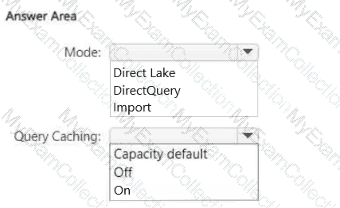
You have a Fabric warehouse that contains a table named SalesOrderDetail. SalesOrderDetail contains three columns named OrderQty, ProductID and SalesOrderlD. SalesOrderDetail contains one row per combination of SalesOrderlD and ProductID.
You need to calculate the proportion of the total quantity of each sales order represented by each product within the sales order.
Which T-SQL statement should you run?
A)

B)

C)

D)

You have a Microsoft Power BI semantic model that contains a measure named TotalSalesAmount. TotalSalesAmount returns a sales revenue amount that is translated into a selected currency.
You need to ensure that the value returned by TotalSalesAmount is formatted to use the correct currency symbol.
What should you include in the solution?
You have a Fabric tenant that contains a new semantic model in OneLake.
You use a Fabric notebook to read the data into a Spark DataFrame.
You need to evaluate the data to calculate the min, max, mean, and standard deviation values for all the string and numeric columns.
Solution: You use the following PySpark expression:
df .sumary ()
Does this meet the goal?
Note: This section contains one or more sets of questions with the same scenario and problem. Each question presents a unique solution to the problem. You must determine whether the solution meets the stated goals. More than one solution in the set might solve the problem. It is also possible that none of the solutions in the set solve the problem.
After you answer a question in this section, you will NOT be able to return. As a result, these questions do not appear on the Review Screen.
Your network contains an on-premises Active Directory Domain Services (AD DS) domain named contoso.com that syncs with a Microsoft Entra tenant by using Microsoft Entra Connect.
You have a Fabric tenant that contains a semantic model.
You enable dynamic row-level security (RLS) for the model and deploy the model to the Fabric service.
You query a measure that includes the username () function, and the query returns a blank result.
You need to ensure that the measure returns the user principal name (UPN) of a user.
Solution: You update the measure to use the USEROBJECT () function.
Does this meet the goal?
You have a Fabric tenant that contains 30 CSV files in OneLake. The files are updated daily.
You create a Microsoft Power Bl semantic model named Modell that uses the CSV files as a data source. You configure incremental refresh for Model 1 and publish the model to a Premium capacity in the Fabric tenant.
When you initiate a refresh of Model1, the refresh fails after running out of resources.
What is a possible cause of the failure?
You have a Fabric workspace named Workspace1 that contains a dataflow named Dataflow1. Dataflow1 returns 500 rows of data.
You need to identify the min and max values for each column in the query results.
Which three Data view options should you select? Each correct answer presents part of the solution.
NOTE: Each correct answer is worth one point.
You need to create a DAX measure to calculate the average overall satisfaction score.
How should you complete the DAX code? To answer, select the appropriate options in the answer area.
NOTE: Each correct selection is worth one point.


You have an Azure Data Lake Storage Gen2 account named storage! that contains a Parquet file named sales.parquet.
You have a Fabric tenant that contains a workspace named Workspace1.
Using a notebook in Workspace1, you need to load the content of the file to the default lakehouse. The solution must ensure that the content will display automatically as a table named Sales in Lakehouse explorer.
How should you complete the code? To answer, select the appropriate options in the answer area.
NOTE: Each correct selection is worth one point.

You need to recommend which type of fabric capacity SKU meets the data analytics requirements for the Research division. What should you recommend?
What should you use to implement calculation groups for the Research division semantic models?
You need to ensure that Contoso can use version control to meet the data analytics requirements and the general requirements. What should you do?
You need to refresh the Orders table of the Online Sales department. The solution must meet the semantic model requirements. What should you include in the solution?
Which workspace rote assignments should you recommend for ResearchReviewersGroupl and ResearchReviewersGroupZ? To answer, select the appropriate options in the answer area.
NOTE: Each correct selection is worth one point.

You need to recommend a solution to group the Research division workspaces.
What should you include in the recommendation? To answer, select the appropriate options in the answer area.
NOTE: Each correct selection is worth one point.
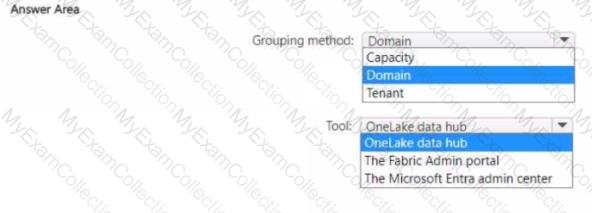
Which syntax should you use in a notebook to access the Research division data for Productlinel?
A)

B)

C)

D)

Which type of data store should you recommend in the AnalyticsPOC workspace?
You need to implement the date dimension in the data store. The solution must meet the technical requirements.
What are two ways to achieve the goal? Each correct answer presents a complete solution.
NOTE: Each correct selection is worth one point.
You have a Fabric tenant that contains a lakehouse named Lakehouse! Lakehouse1 contains a Delta table that has one million Parquet files.
You need to remove files that were NOT referenced by the table during the past 30 days. The solution must ensure that the transaction log remains consistent, and the ACID properties of the table are maintained
What should you do?
You have a KQL database that contains a table named Readings.
You need to query Readings and return the results shown in the following table.

How should you complete the query? To answer, select the appropriate options in the answer area.
NOTE: Each correct selection is worth one point.
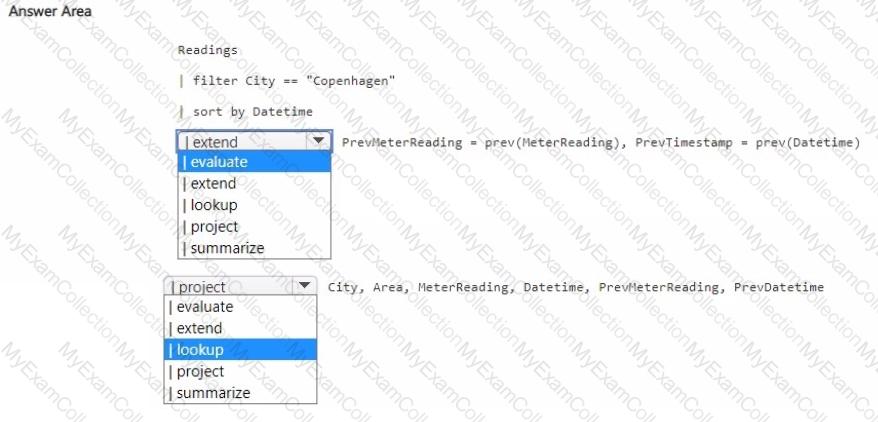
You have a Microsoft Power B1 report and a semantic model that uses Direct Lake mode. From Power Si Desktop, you open Performance analyzer as shown in the following exhibit.
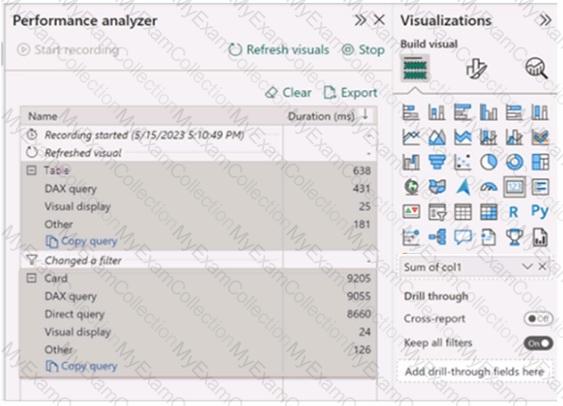
Use the drop-down menus to select the answer choice that completes each statement based on the information presented in the graphic. NOTE: Each correct selection is worth one point.

You have a Fabric workspace named Workspace 1 that contains a dataflow named Dataflow1. Dataflow1 has a query that returns 2.000 rows. You view the query in Power Query as shown in the following exhibit.

What can you identify about the pickupLongitude column?
You have a Fabric tenant
You plan to create a data pipeline named Pipeline1. Pipeline1 will include two activities that will execute in sequence. You need to ensure that a failure of the first activity will NOT block the second activity. Which conditional path should you configure between the first activity and the second activity?
You have a Fabric workspace named Workspace1 and an Azure Data Lake Storage Gen2 account named storage"!. Workspace1 contains a lakehouse named Lakehouse1.
You need to create a shortcut to storage! in Lakehouse1.
Which connection and endpoint should you specify? To answer, select the appropriate options in the answer area.
NOTE: Each correct selection is worth one point.
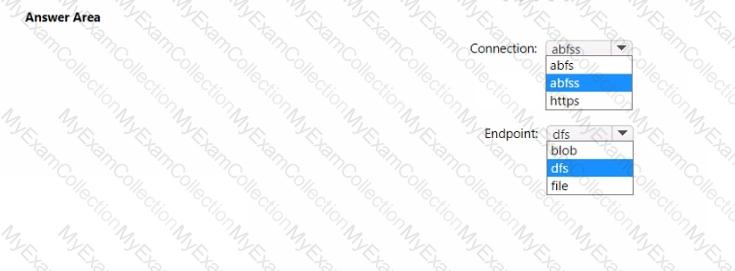
You have a Fabric warehouse that contains a table named Sales.Orders. Sales.Orders contains the following columns.
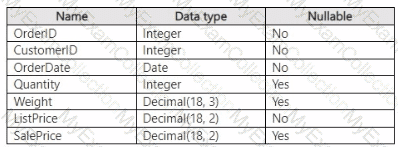
You need to write a T-SQL query that will return the following columns.

How should you complete the code? To answer, select the appropriate options in the answer area.
NOTE: Each correct selection is worth one point.
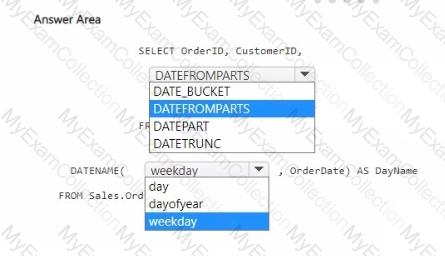
What should you recommend using to ingest the customer data into the data store in the AnatyticsPOC workspace?
You to need assign permissions for the data store in the AnalyticsPOC workspace. The solution must meet the security requirements.
Which additional permissions should you assign when you share the data store? To answer, select the appropriate options in the answer area.
NOTE: Each correct selection is worth one point.
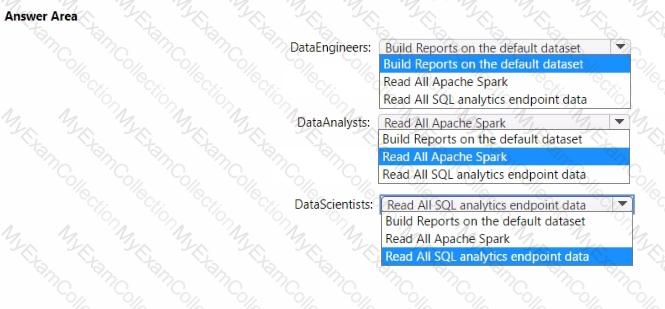
You need to migrate the Research division data for Productline2. The solution must meet the data preparation requirements. How should you complete the code? To answer, select the appropriate options in the answer area
NOTE: Each correct selection is worth one point.


